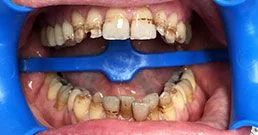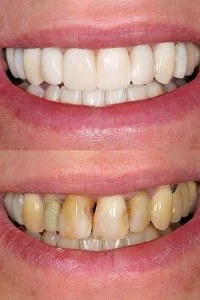Defining tooth decay
Tooth decay – often called cavities or caries – is the process during which different bacteria and acids attack the tooth and cause damage to its layers. Caries are one of the most common health problems worldwide.
In this article you will read about following:
Causes and symptoms of tooth decay
The enamel is a solid and resistant material that constitutes the outer layer of our teeth. It is primarily responsible for the protection of the tooth. Tooth enamel ensures protection against external effects such as hot liquids or cold air, but also against different bacteria and acids that get into our oral cavity with food.
The enamel mainly consists of mineral acids.
The devastating effect of the bacteria causes a serious breakdown in these minerals. As a result, the dentin that the enamel should protect, becomes affected as well.
The dentin is the second layer of our tooth which defines its colour. Bacteria spreading over the enamel and thus affecting the dentin may lead to toothache and tooth sensitivity.
Stages of tooth decay
The more devastating the effects of the bacteria are, the more advanced stage of decay the patient has to deal with. Accordingly, tooth decay can be considered as a process that specialists fundamentally divide into three phases/stages.
Early-tooth-decay
During the first stage, the enamel might be able to protect the dentin by absorbing the infection. However, this causes a breakdown in its minerals. At this stage the patients may not experience a toothache and there is no significant deformation in the teeth, even though white spots may appear on the surface of the enamel.
Decay in the dentin
In case the enamel fails to prevent the bacteria from spreading towards the inside of the tooth, we are dealing with a further stage of decay which usually involves toothache or tooth sensitivity.If caries spread over the border of the enamel and damage the dentin, it creates a hole on the surface.
Serious cases of tooth decay
In the most serious cases caries does not only damage the dentin. The bacteria and acids may even reach the nerves located in the pulp space – the innermost area in our teeth. The result might be great pain or even tooth loss, and serious complications can also arise in the long term.
The treatment of tooth decay
The successful treatment of tooth decay makes up a significant percentage of dental treatments. Patients often visit the dentist’s surgery room due to mild or severe toothache caused by tooth decay. However, it may also happen that the therapist recognizes changes at an early stage during regular medical checks. Let us see what can be done with tooth decay at different stages.
Early-tooth-decay
As long as the decay has not reached further stages and has only affected the enamel, the process can be reversed to a certain extent.
Dentists usually recommend the use of specific toothpaste or different gels.
These contain higher quantities of fluoride that helps restore the minerals in the enamel. Patients who have first-stage tooth decay must pay particular attention to brushing their teeth thoroughly and regularly.
Decay in the dentin
If the caries spread over the border of the enamel and damage the dentin, it creates a hole on the surface. At this stage, the treatment mentioned above will not be sufficient, but the patient needs a dental filling. This is a common problem.
Patients often visit their dentists to have their damaged tooth filled. During the process, the doctor fills the hole with a special material. Amalgam, for instance, was used for a long time for dental fillings. Even though it is still applied by certain clinics, other, more aesthetic fillings made of plastic or porcelain are the popular solutions today. Dental fillings, of course, do not only consist of the filling of the hole in the damaged tooth. Cleaning and disinfecting the affected area, for instance, also constitutes a vital part of the process.
Serious cases of tooth decay

In more advanced stages of tooth decay, the affected tooth can be in great danger. In such cases, the decay spreads further into the inner part of the tooth and affects the nerves in the pulp, possibly causing inflammation, high fever or the swelling of the patient’s mouth. The applicable procedure, in this case, is root canal treatment.
During the process, the expert removes the damaged nerve tissues from the tooth and inserts a filling so that the tooth can function as normal again. Root canal treatment – also called endodontic therapy – is a very complex procedure.
Depending on the level of damage in the tooth, a dental crown might also become necessary. Dental crowns, as the name suggests, are applied on the top of the tooth covering the whole surface. They have a crucial role in tackling aesthetic and functional problems. There are also occasions when the condition of a tooth that has previously been treated deteriorates, and the treatment methods listed above do not suffice. In these cases, dentists may have to remove the affected tooth completely. Although tooth extraction can solve the problem of tooth decay when the other methods cannot, a missing tooth creates difficulties with chewing, and it is considered a serious aesthetic problem as well.
Practical tips for preventing dental caries
As we have already indicated, one of the most important secrets of preventing and curing tooth decay in time is the regular medical check, twice a year at least. The passage of time has a highly negative effect on dental caries.
Let us see what other things one should keep in mind to avoid major intervention:
Avoid consuming an excessive amount of sugar, alcohol, high-acid food, and snacks.
High and regular water consumption.
Brushing your teeth twice a day at least, ideally after every meal, with toothpaste containing fluoride.
Healthy eating habits, adequate supplementation of vitamins, and minerals.
We can see that tooth decay at an early stage can be easily recognized and treated remarkably well. Do not postpone the check, as soon as you detect the first symptom or change, visit your dentist immediately.



